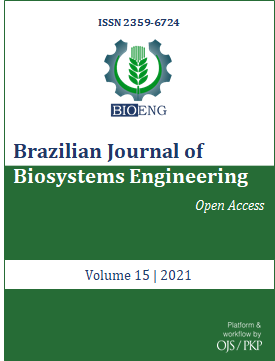MACROAGGREGATION OF A PALEUDALF AFFECTED BY CAVITATION INTENSITY AND MANAGEMENT SYSTEMS WITH COVER PLANTS
DOI:
https://doi.org/10.18011/bioeng2021v15n2p283-302Keywords:
Amplitude of vibration, Ultrasound, Wet sieving.Abstract
Ultrasonic-based techniques allow the prediction of the energy required to break the aggregate and have been more commonly used to measure the stability of aggregates. Although they result in the same applied energy, certain combinations of time and power might correspond to different intensities of cavitation. Consequently, different responses in aggregation indexes can be obtained with different configurations of ultrasound techniques. Thus, this work was carried out to evaluate the effects of cavitation intensity in the distribution of aggregates of a Paleudalf under management systems with cover plants and to compare aggregate stability determination methods (ultrasound versus wet sieving). Aggregate samples of the BS (bare soil), OT (black oat + forage turnips) and OV (black oat + hairy vetch) treatments were exposed to ultrasonic irradiation in different combinations of potency and time: (U1) 74.5 W/4 s; (U2) 49.7 W/6 s; (U3) 74.5 W/10 s and (U4) 49.7 W/15 s. After each sonification, the samples were passed in the same set of sieves used in the standard method of wet sieving -WS (8.00 - 4.76, 4.76 - 2.00, 2.00 - 1.00, 1.00 - 0.25 and < 0.25 mm) and the geometric mean diameter (GMD) and mass-weighted mean diameter (WMD) were calculated. The amplitude of vibration exerted a greater influence on soil breakdown than the total energy applied. Compared to the ultrasound method, in the WS method observed higher percentage of retained aggregates in the size class 8-4.76 mm and, consequently, greater aggregation indexes GMD and WMD.
Downloads
References
ALVARES, C. A.; STAPE, J.L.; SENTELHAS, P.C.; DE MORAES, J.L.G.; SPAROVEK, G Köppen's climate classification map for Brazil. Meteorologische Zeitschrift, v.22, n.6, p.711-728, 2013. Doi.org/10.1127/0941- 2948/2013/0507
HOORMAN, J.J. Using cover crops to improve soil and water quality. Lima, Ohio: Agriculture and Natural Resources. The Ohio State University Extension, 2009.
KEMPER, W.D.; CHEPIL, W.S. Size distribution of aggregates. In: BLACK, C.A. (Ed.). Methods of soil analysis. Madison. American Society of Agronomy, v.1, p.499-509, 1965.
LOSS, A.; BASSO, A.; OLIVEIRA, B.S.; KOUCHER, L.P.; OLIVEIRA, R.A.; KURTZ, C.; LOVATO, P.E.; CURMI, P.; BRUNETTO, G.; COMIN, J.J. Carbono orgânico total e agregação do solo em sistema de plantio direto agroecológico e convencional de cebola. Revista Brasileira de Ciência do Solo, v.39, p.1212-24, 2015. Doi.org/10.1590/01000683rbcs20140718
MAYER, H.; MENTLER, A.; PAPAKYRIACOU, M., RAMPAZZO, N.; MARXER, Y.; BLUM, W.E.H. Influence of vibration amplitude on the ultrasonic dispersion of soils. International Agrophysics, v.16, p.53-60, 2002.
NORTH, P.F. Towards an absolute measurement of soil structural stability using ultrasound. Journal of Soil Science, v.27, p.451-459, 1976. Doi.org/10.1111/j.1365-2389.1976.tb02014.x
PILLI, S.; BHUNIA, P.; YAN, S.; LEBLANC, RJ.; TYAGI, R.D.; SURAMPALLI, R.Y. Ultrasonic pretreatment of sludge: a review. Ultrasonics Sonochemistry, v.18, p.1-18, 2011.Doi.org/10.1016/j.ultsonch.2010.02.014
RAINE, S.R.; SO, H.B. An energy based parameter for the assessment of aggregate bond energy. Journal of Soil Science, v.44, p.249–59, 1993. Doi.org/10.1111/j.1365-2389.1993.tb00449.x
RAINE, S.R.; SO, H.B. Ultrasonic dispersion of soil in water: The effect of suspension properties on energy dissipation and soil dispersion. Australian Journal of Soil Research, v.32, p.1157–74, 1994. Doi.org/10.1071/SR9941157
RAINE, S.R.; SO, H.B. An investigation into the relationship between dispersion, power, and mechanical energy using the end-over-end shaking and ultrasonic methods of aggregate stability assessment. Australian Journal of Soil Research, v.35, p.41-53, 1997. Doi.org/10.1071/S96063
R DEVELOPMENT CORE TEAM. R: a language and environment for statistical computing. R Foundation for Statistical Computing, Vienna, Austria. 2018.
RIBEIRO, B.T.; LIMA, J.M.; OLIVEIRA, G.C.; CURI, N.; SILVA, E.A.; SILVA, B.M. Ultrasonic aggregate breakdown of an Oxisol as affected by cavitation intensity. Communications in Soil Science and Plant Analysis, v.48, p.818–824, 2017. Doi.org/10.1080/00103624.2017.1299170
RIBEIRO, B.T.; LIMA, J.M.; CURI, N.; OLIVEIRA, G.C. Aggregate breakdown and dispersion of soil samples amended with sugarcane vinasse. Scientia Agricola, v.70, p.435–41, 2013. Doi.org/10.1590/S0103-90162013000600009
RIBEIRO, B.T.; LIMA, J.M.; MELLO, C.R.; SÁ, M.A.C.; OLIVEIRA, G.C. Relationship between raindrops and ultrasonic energy on the disruption of a Haplic Cambisol. Ciência e Agrotecnologia, v.33, p.814-823, 2009. Doi.org/10.1590/S1413-70542009000300021
SÁ, M.A.C.; LIMA, J.M.; SILVA, M.L.N.; DIAS JÚNIOR, M.S. Índices de desagregação do solo baseado em energia ultra-sônica. Revista Brasileira de Ciência do Solo, v.23, p. 525-531, 1999. Doi.org/10.1590/S0100-06831999000300005
SÁ, M.A.C.; LIMA, J.M.; SILVA, M.L.N.; DIAS JÚNIOR, M.S. Comparação entre métodos para o estudo da estabilidade de agregados em solos. Pesquisa Agropecuária Brasileira, v.35, p.1825-1834, 2000. Doi.org/10.1590/S0100-204X2000000900015
SCHOMAKERS, J.; MENTLER, A.; STEURER, T.; KLIK, A.; MAYER, H. Characterization of soil aggregate stability using low intensity ultrasonic vibrations. International Agrophysics, v.25, p.165–72, 2011.
SILVA, É.A.; MALLMANN, M.S.; PEREIRA,M.A.; REINERT,D.J.; REICHERT, J.M. Energia ultrassônica na avaliação da macroagregação de um argissolo sob manejo conservacionista com diferentes plantas de cobertura. Agrarian, Dourados, v. 14, n. 52, p. 223-232, 2021. Doi.org/10.30612/agrarian.v14i52.14311
SILVA,É.A.; REINERT,D.J.; REICHERT,J.M.; MALLMANN, M.S.;PEREIRA,M.A.;PONS,S.S.; FOGGIATO, W.S. Soil conservation management with cover crops: effects on critical energy levels, release and dispersion of aggregates. Bragantia, v.78, p.444-453, 2019.
SILVA, É.A.; OLIVEIRA, G.C.; CARDUCCI, C.E.; LIMA, J.M.; MELO, L.B.B.; BENEVENUTE, P.A.N. Stability of soil aggregates in Latosols and Cambisols via standard method and sonification. African Journal of Agricultural Research, v.11, p.3894-3903, 2016. Doi.org/10.5897/AJAR2016.11192
TEDESCO, M.J.; GIANELLO, C.; BISSANI, C.A.; BOHNEN, H.; VOLKWEISS, S.J. Analysis of Soil, Plants and Other Materials (in Portuguese). Universidade Federal do Rio Grande do Sul, Porto Alegre, RS, Brazil. 1995.
UNITED STATES DEPARTMENT OF AGRICULTURE [USDA]. Keys to Soil Taxonomy. 11ed. USDA-NRCS, Washington, DC, USA, 2010.
ZHANG-LIU, D.; TU-SHENG, R.; CHUN-SHENG, H.; QING-ZHONG, Z.; BLANCO-CANQUI, H. Soil Aggregate Stability and Aggregate-Associated Carbon Under Different Tillage Systems in the North China Plain. Journal of Integrative Agriculture, v.12, p. 2114-2123, 2013.
Downloads
Published
How to Cite
Issue
Section
License
Copyright (c) 2021 The Authors

This work is licensed under a Creative Commons Attribution 4.0 International License.
By publishing in this journal, authors agree to the following terms:
a) Authors retain copyright and grant the journal the right of first publication. The work is simultaneously licensed under the Creative Commons Attribution License, which permits sharing and adaptation of the work with appropriate credit to the authors and the journal.
b) Authors may enter into separate, additional agreements for non-exclusive distribution of the published version of the work (e.g., posting to an institutional repository or inclusion in a book), provided that proper credit is given to the original publication in this journal.










